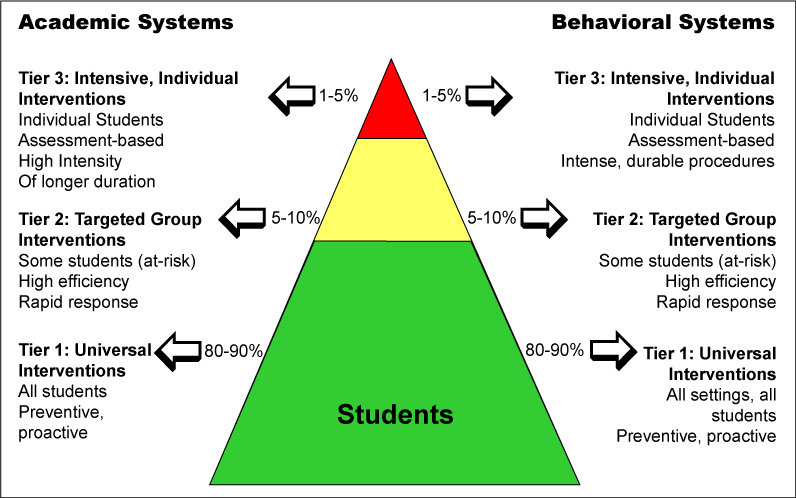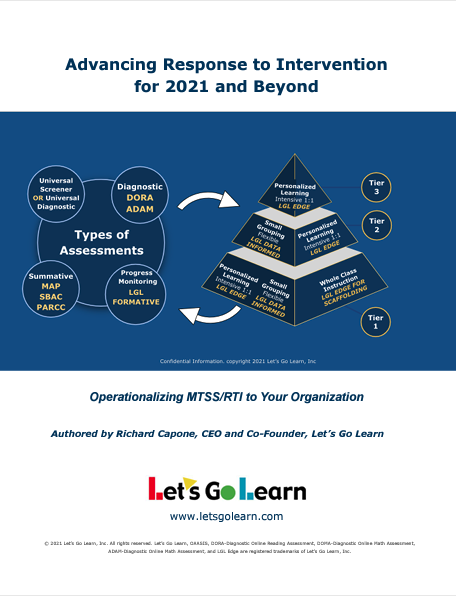This article assumes that you already understand the basic tenets of Response to Intervention (RtI) and will focus on how RtI can be improved and evolved to better meet the needs of students, as well as fit the technologies and conditions in today’s classrooms and districts. If you need a refresher on RtI, reference this basic definition first. This article also applies to Multi-Tiered System of Supports as RtI is an important subset of MTSS.
Explore more topics in special education
Changing Assumptions from 2004 to 2021
RtI was formally introduced in the 2004 reauthorization of the Individuals with Disabilities Act (IDEA). However, in the almost 20 years since then, many conditions have changed.
- Computer-adaptive testing is widespread today. In 2004, most assessments were summative only. One of the few computer-adaptive assessments was the Diagnostic Online Reading Assessment (DORA), released in 2001.
- Computer access is one-to-one in over 50% of classrooms today. In 2004, this percentage was less than 3%.
- Classrooms are more diverse ethnically, socioeconomically, and academically.
- Online differentiated instruction is the norm today. Dozens of companies have products that adjust to students based on their abilities or that are personalized based on data up front.

Increased Need for Intervention
Originally, RtI was designed for a context in which the regular classroom, or Tier 1, addressed 80% of the students, 10-15% were in Tier 2 for pull-out intervention, and 3-5% were students with IEPs. But today these numbers rarely exist in medium to larger districts. We are seeing numbers such as 60% Tier 1, 30% Tier 2, and 10% Tier 3. It is not easy to pull 30% of your students out into intervention. Also, in the case of mathematics in middle school, it is very common to see districts with only 25% to 35% proficiency. This translates to over 40% of students being two or more years behind and 15-20% being within one year behind. These numbers break a traditional RtI model.
What Is the Solution?
Intervention is needed for all students, especially in mathematics, which is so skills based that by the 5th or 6th grade, students cannot learn much from the core materials if they have fallen behind and their foundational skills are weak. They are essentially lost in class. The problem is that these institutional biases exist that impede reform:
Step One
Recognize Common Internal Biases and Dispel Them.
- Above all, I need to cover the standards (or pacing guide) for my class.
- I don’t have time for small-group instruction.
- There isn’t enough time for personalized learning.
- Computer-based personalized learning is bad; the teacher is the best teacher.
Let’s address each one at a time.
Bias 1: Above all, I need to cover the standards for my class.
Modern standards are grade-level standards. They assume students have foundational skills and concepts mastered. If this is not the case, then it becomes increasingly difficult for students to learn the grade-level standard. Making it the highest priority to cover the standards at a school with ELA or Math when proficiency is less than 70% is a mistake; it is valuing equality over equity.
Bias 2: I don’t have enough time for small-group instruction.
Whole-group instruction in foundational subjects such as ELA or Math is not equitable. It can be a part of the lesson plan, but individual student needs must be met. ELA and Math from grades K to 8 need to have small-group instruction built in (e.g., Flexible Fridays, personalized learning flex period, etc.).
Bias 3: There isn’t enough time for personalized learning.
Personalized learning is needed to enable students to work on their individual gaps. It can be combined with small-group instruction so that students who are not working with the teacher are working on their own individual needs. Making time for personalized learning should be a high priority, as it is for students with IEPs. Schools need to get creative here.
Bias 4: Computer-based personalized learning is bad; the teacher is the best teacher.
Computer-based personalized learning should be seen as an extension of the teacher. The teacher is like the head chef in a large kitchen. Sometimes, the head chef chops and cooks, but other times the sous-chefs are executing tasks. Make no mistake: computer-based learning programs operate under the direction of the teacher. The teacher turns them on or off and personally assigns lessons to each student. Computer-based personalized learning is a multiplier of the teacher.
Step Two
Implement New Technologies to Help Improve Your RtI Implementation.
- Use a universal diagnostic instead of a universal screener for the initial step of RtI. Universal screeners can only sort students into tiers. They lack the granularity to diagnose. Universal diagnostics get you detailed data up front.
- Pro-Tip: Administrators, STOP assuming teachers can magically sort students into small groups each day based on screeners, summative assessments, district benchmark tests, or their own observations. They CANNOT do this. It is not possible for all teachers given their varying abilities, levels of experience, and time available.
- Give your teachers and their respective professional learning communities (PLCs0 good data to use and train them.
- Pro-Tip: Administrators, STOP thinking that grade-level-focused benchmark data informs instruction. When 50% of your students are over a year behind, benchmark data can only reveal that these kiddos are failing–not why. They won’t group. They won’t inform PLCs very well.
- Pro-Tip: Administrators, STOP thinking that norm-based assessments can inform instruction. A single “reading” score–a score looking like 750, 5.5 GLS, or 75%–won’t inform instruction.
- Commit to one-to-one devices for all students.
- Chromebooks are inexpensive. Smartphones are present in all households, including those with low-income families. It is actually very difficult to get a dumb phone anymore in the U.S.
- One to one means intervention can happen in Tiers 1, 2, and 3 as teachers see fit. It acts as a multiplier in effectiveness for a good teacher.
Step Three
Be Bold and Commit to Reforms That Will Move the Needle!
- Commit to personalized learning for grades K to 8 at a minimum.
- One flex day for all ELA/Math classrooms grades K to 8.
- Add a period in the day for personalized learning at middle school.
- Summer boot camp for at-risk students that is 100% personalized learning.
- Add after-school intervention programs.
- Adopt a data model to guide your district’s schools and teachers.
- Assessment-Instruction model
- Data cycle of inquiry
- Process-monitoring articulation plan. When, how often, for whom?
- Empower students and families in the learning process.
- Share diagnostic reports with students starting in grades 1 or 2 and above.
- Share reports with parents or guardians.
- Have students set weekly or monthly goals.
- Give Special Education modern computer-adaptive diagnostic assessments and not spill-over assessments used in general education.
- MAP: Too long, not designed for students with IEPs. Data doesn’t inform instruction. Designed as the most accurate accountability measure for general education.
- STAR Math and STAR Reading: These are screeners. They don’t inform instruction well for special educators.
Online tools for special education
Conclusion
Reform is hard and advocating for a modified RtI model can be difficult. It is challenging to propose something different, especially when educational organizations often make decisions by consensus. It can be helpful to pull back and look at the big picture when building your case. If your district has low proficiency rates in the 35-40% range or less, aggressive moves have to be made; otherwise, you will never close the gaps. This hard reality needs to be made clear to everyone. This is an all-hands-on-deck situation. Failure means failure in equity, failure to help our most vulnerable and needy population–our nation’s children. Next, it is important to be able to make decisions based on specifications up front. What type of approach or tools are needed for your middle-school math students, for your elementary ELL students, etc.? I like to use an analogy about buying a vehicle. You initially decide on a class of vehicle. Do you need a truck, car, or SUV? If you are going to move a lot of dirt, you will choose a truck, hands down. If you need to drive long distances with many people, a car is a good choice. You don’t compare a Toyota pickup to a Ford Mustang.
Thus, if you are a district with a lot of inequity, high ELL population, and low proficiency scores, why would your only district assessment be a summative-focused test? You know your students are low, so why are you worried about predicting their “standards” score when you know they are not at grade level? You need to drop the norm-referenced assessment and go for the test special educators would choose, the one that is the most diagnostic. Also, which interventions have strong language components? We know language is a huge factor in student achievement. So determine these specifications up front and then move forward. This will streamline the process of finding the right tools, programs, and approach. It will actually bring quite a bit of clarity. The more specifically you define your needs, the narrower your choices become–meaning your district’s path will become clear. Good luck.



I would like to use your pyramid in my dissertation. Was the image created by you or does it belong to someone else? Please let me know if I have permission to use it.